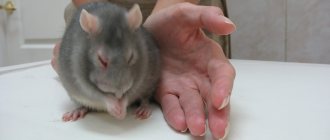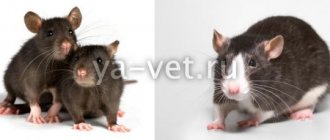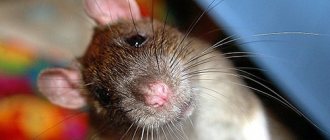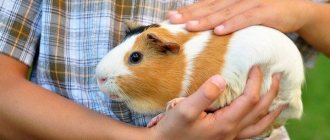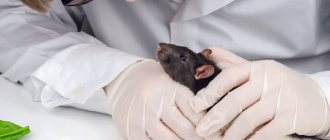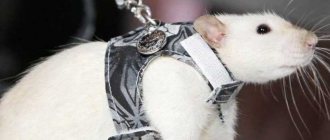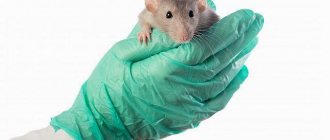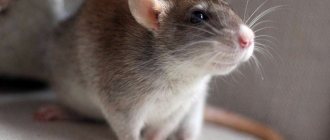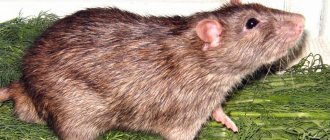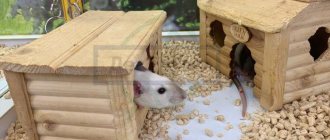The rat’s tail has darkened or is peeling, what should I do?
Rats are considered one of the cleanest animals. But their tail is a part of their body that can sometimes get a little dirty. You can tell if a tail is very dirty by looking at the color: if it is darker than usual, it may be time to wash it. If the tail is very dirty, it can also peel off.
Cleaning a rat's tail is quite simple. Simply use a soap and water solution, dip a piece of cloth in it, and wipe the tail. If the tail is very dirty, you can also soak it in a warm solution of soap and water.
When cleaning a rat's tail, be careful. It is better not to suddenly grab animals by the tail. This can frighten them and even traumatize them.
A rat fell from a height, what should I do?
If a rat has fallen from a height, you should first calm the pet down. Do not touch the animal for several minutes, let the rat come to its senses. However, do not lose sight of the rodent. If the pet has not recovered from shock after a long time, inject 0.1 ml of Prednisolone subcutaneously (into the withers) and pour 0.5 ml of Nurofen into the oral cavity to eliminate any discomfort.
Then monitor the rat's behavior for 48 hours. If the animal behaves normally and can move around calmly, then everything is fine with the rodent. However, if your pet begins to limp and lick its tail or limbs, seek help from a veterinary clinic.
Drowning
Another of the easiest ways to kill a caught rat is to drown it. If you catch a pest in a bucket or barrel, you can cover the animal with a thick rag and put a heavy object on top so that the rat does not jump out. Then simply fill the container with water.
But here you will have to try to ensure that the rodent is well pressed to the bottom, because, sensing the approach of death, it can get a surge of strength and try to escape from under the load, so it is recommended to press the rag with a stick and hold it there for several minutes until it choke and die. You can simply pour the dead animal out of the bucket and prepare a trap for subsequent rodent catching.
My pet has blood in his urine, what should I do?
Seeing blood in a rat's urine is definitely scary. Blood means something is going wrong somewhere in the urinary tract, with many possible causes. Hematuria is not a condition that can go unnoticed by the owner; it needs to be treated immediately. Each potential cause of this dreaded symptom can potentially lead to death if left untreated. Not every condition will cause a rat to meet its untimely death, but it is quite possible if the rat's health is neglected.
The main reasons for the appearance of blood in a pet’s urine:
- Bladder infection
A urinary tract infection can cause blood when you urinate. Severe infections can cause severe damage to the urinary tract, resulting in bleeding. Bleeding indicates a sufficiently advanced infection that requires immediate treatment to save the rat's life.
- Kidney disease or failure
If the kidneys become diseased or begin to fail, they too can cause blood to form in the rat's waste. Severe kidney inflammation may even result in excessive or very little urine output, depending on the condition of the kidneys. Most owners may not know what is normal for their rat, so it is always a good idea to monitor your rat's litter box habits when you suspect the animal may be sick or not feeling well.
- Stones in the kidneys
Just like humans, rats can get kidney stones. As you might have guessed, it's incredibly painful for them too. As kidney stones travel from the kidney to the bladder and out the urethra, they can cause some damage. Rats with kidney stones need to be given antibiotics to prevent the damage from leading to infection. Poor diet may also be a major cause.
- Worms in the bladder
Threadworms are highly invasive parasites that can destroy a rat's bladder and ultimately kill it. Antiparasitic drugs will be needed here. If the worms are not killed, the rat's health will only deteriorate. In addition, any other rats that share the cage with the infected rat will need to be treated. It's almost a promise that other rats are also infected to some degree.
- Tumors and cancers
Unfortunately, rats can develop cancer of the urinary tract. Most often it is kidney cancer or bladder cancer. Other neoplasms and tumors can also affect the urinary system, especially in later stages. Any tumor in a body cavity can grow large enough to shut down the kidneys or the entire urinary system. In this case, the rat should be euthanized when the quality of life deteriorates significantly.
The best way to get rid of blood is to eliminate the cause of the bleeding. A rat will not urinate blood for no reason. Instead, there is something that is causing damage to the urinary tract. Any bacterial infection will require rat-safe antibiotics.
In case of inflammation, steroids and anti-inflammatory drugs may be prescribed. This will reduce swelling, preventing the organ or tissue from causing more harm to itself, and as a result, reduce pain. Bacterial infections will require one of a variety of antibiotics, depending on what pathogen is causing the infection. When it comes to pain, such as kidney stones or tumors, painkillers such as Metacam can significantly improve the quality of life of a sick rat.
Symptoms of postcholecystectomy syndrome
At its core, PCES is a consequence of surgery for resection (removal) of the gallbladder. This means that after resection the patient may experience unpleasant symptoms, such as:
- dyspepsia or disruption of the normal functioning of the stomach, manifested in the form of bitterness in the mouth, nausea, bloating and intestinal upset;
- pain in the right hypochondrium with transition to the right collarbone or shoulder. The intensity of pain can vary, from unexpressed aching to acute burning;
- general weakness, pale skin (appears against the background of poor absorption of food and developing vitamin deficiency).
With PCES, other symptoms are possible due to exacerbated diseases:
- exacerbation of cholangitis - inflammation of the bile ducts - is expressed in a long-lasting temperature in the range of 37.1-38.0 ° C;
- Cholestasis (stagnation of bile in the liver tissue) can cause severe jaundice2.
The rat choked, what should I do?
Choking is a painful act that occurs mainly due to negligence. This is a life-threatening situation because in this situation the airway is blocked. This condition is usually caused by food particles. Food, instead of getting into the proper path it should take, will move towards the respiratory tract, which causes suffocation. If you don't act quickly, it can be fatal to the rat.
To prevent the possibility of food getting stuck in the animal’s throat, it is necessary to develop a safe diet for the rodent. If a rat chews its food incorrectly, choking may occur. Thus, the diet should only include food that the pet can easily chew and swallow very easily.
If your rat is choking, you can prevent choking using the following methods:
- Turning over the animal
This is the easiest way to immediately remove the choking hazard. The owner needs to turn the rodent's body over and bend it slightly. In such a way that you can press his chest with your palm. It is necessary to press on the chest with very careful movements. Chest compression helps the pet clear the object from the airway so it can be saved.
- Use a cotton swab
Using a cotton swab, you can remove the object from the rat's respiratory tract. In this method, a stick is inserted into the throat through the mouth. Such a stick can penetrate deep into the throat and pull out an object.
- Operation
This method is very critical and risky. Specialists make an incision in the neck to remove the foreign object from the airway. If the previous two methods did not work, then this is the last method that can save your pet's life. The operation can only be successful if it is performed on time.
Diagnosis of postcholicystectomy syndrome
Difficulties in accurately determining the causes that led to the development of PCES and the vagueness of the very definition of the syndrome require a thorough examination of the patient. In order to choose the right treatment, it is necessary to clearly establish what led to the appearance of PCES.
That is why effective diagnosis of postcholicystectomy syndrome includes several methods:
- collection of anamnesis data - the doctor carefully studies old medical reports and records, paying close attention to preoperative diagnostics and the protocol of the operation;
- clinical examination of the patient;
- laboratory tests - clinical and biochemical blood test, stool test for protozoa and worm eggs, general urine test;
- ultrasonography;
- endoscopy of the bile ducts;
- Magnetic resonance imaging or computed tomography of the abdomen6.
The rat began to hiccup frequently, what should I do?
Rat hiccups are not exactly like human hiccups. If your rat rarely hiccups, then this is normal. But in any other case, it could be a sign of respiratory problems and lead to something serious.
Hiccups are an involuntary spasm of the diaphragm muscle. As a natural reflex, the vocal cord closes, resulting in the characteristic human sound of hiccups. But when it comes to rats, the sound cannot be heard. But you can notice rhythmic twitching of the body.
There are several ways to find out if your rat's hiccups can be simply ignored or if you need to take serious action. The first way is to check whether the animal's hiccups have a sound. Normal hiccups in rats are silent. If hiccups are accompanied by a squeaking sound, this may be a sign of a respiratory problem.
Another way to tell if a rat's hiccups can be ignored is to see if they continue to move between hiccups. If they do this, it is a sign that the hiccups are a passing phenomenon. If instead they stay in one place (usually in a corner) while they do this, then this is a sign of something more serious. In this case, you should consider taking your rat to the vet for a full examination.
Under normal conditions, rats hiccup as a result of excitement. This can happen while playing or while eating. Although some rats hiccup when they are upset or angry, hiccups are mostly associated with positive feelings of arousal.
But in more serious cases, rat hiccups may be a symptom of active Myco pulmonis, a certain bacteria that pet rats are infected with from birth. Some researchers even believe that any hiccups in rats are due to Myco pulmonis infections.
Most veterinarians will recommend some kind of antibiotic for this condition, such as Baytril (2 mg/tablet for rats) and Doxycycline for 2-6 weeks. Most rats recover by this time and the hiccups go away.
All rats are born with a predisposition to Myco infection and will show symptoms (such as hiccups) every now and then. Some rats show symptoms more often than others. If you follow all the recommendations of experts, your furry friend will recover in no time.
Causes of colds
Decorative rats are bred specifically to live in an artificial environment near humans. Compared to their wild ancestors, their immunity is much weaker. Therefore, they often suffer from respiratory diseases, the pathogens of which enter their body from a sick person. Therefore, if there is a sick person in the house, the rat must be quarantined. If this is not possible, then contact with the patient should be reduced as much as possible; the animal should be fed and watered while wearing a protective mask.
Most often, cold infections are recorded in the cold season (from October to March). Infection is also facilitated by a decrease in fresh greens in the diet. These products contain vitamins, minerals, and other biologically active components that stimulate the animal’s body’s defenses.
Another negative factor operating during this period is the operation of heating devices, which contributes to drying out the air. Breathing such air leads to drying out of the mucous membranes of the nasopharynx. And this means a significant decrease in local immunity, since the mucus secreted by the epithelium contains a large amount of interferons and antibodies.
Infection with cold pathogens is also facilitated by:
- keeping in a drafty room, but lack of ventilation can also provoke illness;
- hypothermia;
- insufficient or poor quality nutrition;
- deficiency in food of vitamins (especially A and C), minerals;
- excessive dampness or dry air.
Due to exposure to one or more of these factors, the body's defense system is further weakened and loses its ability to quickly neutralize pathogens. As a result, the pathogen that has penetrated the upper respiratory tract has the opportunity to multiply and cause illness. The most common causes are streptobacilli, pneumonia bacilli and diplococci.
How to inject a rat yourself?
To safely administer the injection, the animal must be restrained. This will require two people. Rats are generally docile animals, especially if they are handled regularly using appropriate methods. Rat bites are rare and usually only happen when the animal is stressed or in pain. To hold the rat, one person should gently grab it by the shoulders.
The thumb can then be placed under the rat's lower jaw to prevent biting, and the rat's hind legs can be supported with the other hand. The restriction should be tight, but not too tight, as this will interfere with the animal's breathing.
To administer the medicine subcutaneously to an animal, you need to wrap two fingers around the back of the rat's neck and insert a needle into this area, slowly injecting the solution. With the intramuscular method, a syringe is inserted into the fleshiest part of the thigh.
Posts 1 page 30 of 30
Share12010-01-04 22:23:01
Good evening! My rat is 2 years old, for the last two weeks she has had a lot of discharge from her nose (similar to blood), is breathing heavily, and is sneezing. He doesn’t eat anything (or very little from his hands, if forced), and doesn’t drink water from the drinking bowl (we drink water from a syringe). I have lost a lot of weight, about half, if not more. Weakness is very noticeable, although he walks more or less, he generally drags his hind legs! Doesn't respond when I call, this has never happened before!
Today we went to the clinic, the doctor said it was heart failure! But this begs the question: is it possible to determine (visually) whether this is so? After all, the doctor didn’t even take Sanya in her hands. I just showed her nose, said that she doesn’t eat anything, doesn’t drink, she’s lost so much weight! You can see from the rat that she’s breathing very hard! Actually, that’s all they told me, they added that you can try to treat, pierce, for at least 5 days, if it gets better, then continue, no, put me to sleep!
What do you say about this? ________________________________ thank you in advance!
Share22010-01-04 22:43:57
- Author: Pyatihatochka
- Participant
- From: Ukraine, Kharkov
- Registered: 2009-08-14
- Invitations: 0
- Posts: 8175
- Female gender
- Age: 40 [1980-11-14]
- Spent on the forum: 1 month 28 days
- Last visit: 2013-10-15 19:28:31
Are there any sounds when breathing? Are your paws turning blue? Are your teeth of normal length? Are there still doctors who can LISTEN to the HEART for arrhythmia and the like, as well as the lungs and airways for wheezing?
Please don't be surprised - I edited the title of the topic. Topic titled “Help. “does little to show the essence of the problem and there shouldn’t be 100 such topics on the forum. We need specifics.
